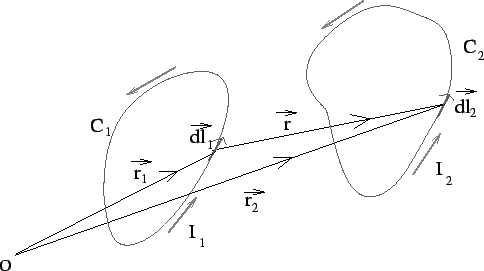SKEDSOFT
If, on the other hand, the current ![]() in the inner solenoid is varied, the field due to it
in the inner solenoid is varied, the field due to it ![]() which is non-zero only within the inner solenoid. The flux enclosed by the outer solenoid is, therefore,
which is non-zero only within the inner solenoid. The flux enclosed by the outer solenoid is, therefore,
![]()
If ![]() is varied, the emf in the outer solenoid is
is varied, the emf in the outer solenoid is ![]() giving
giving ![]()
One can see that ![]() .
.
This equality can be proved quite generally from Biot-Savart's law. Consider two circuits shown in the figure.

The field at ![]() , due to current in the loop
, due to current in the loop ![]() (called the primary ) is
(called the primary ) is 
where ![]() . We have seen that
. We have seen that ![]() can be expressed in terms of a vector potential
can be expressed in terms of a vector potential ![]() , where
, where
, by Biot-Savart's law 
The flux enclosed by the second loop, (called the secondary ) is

Clearly, 
It can be seen that the expression is symmetric between two loops. Hence we would get an identical expression for ![]() . This expression is, however, of no significant use in obtaining the mutual inductance because of rather difficult double integral.
. This expression is, however, of no significant use in obtaining the mutual inductance because of rather difficult double integral.
Thus a knowledge of mutual inductance enables us to determine, how large should be the change in the current (or voltage) in a primary circuit to obtain a desired value of current (or voltage) in the secondary circuit. Since ![]() , we represent mutual inductance by the symbol
, we represent mutual inductance by the symbol ![]() . The emf
. The emf ![]() in the secondary circuit is given by
in the secondary circuit is given by ![]() , where
, where ![]() is the variable current in the primary circuit.
is the variable current in the primary circuit.
Units of ![]() is that of Volt-sec/Ampere which is known as Henry (h)
is that of Volt-sec/Ampere which is known as Henry (h)